by Lisanne Harrington
I come from a family of writers. My mom writes middle-grade historical fiction and my oldest daughter went to film school and is working on two TV pilots, one of her own imagination and one based on real events. I write paranormal and murder mysteries.
What is a Mind Map?
Over the years, I have learned a lot about the methods different writers use to begin their stories. Mom uses something she calls a “mind map,” which involves enormous amounts of oversized paper and so many different colored markers, it’ll make your head do the hokey-pokey…
Seriously, though, a mind map helps a writer brainstorm mental associations, visually representing ideas and their relationship to one another. It’s a non-linear composition tool.
Huh?
The way I understand it, you start with a general idea. Put that in a circle in the middle of the paper, then draw lines to your specifics, things like plot, characters, setting and timeline. The important stuff.
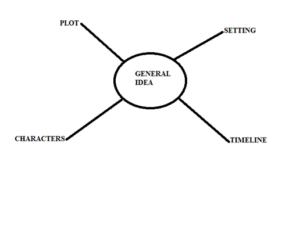
Doesn’t look so bad, right? Silly writer!
General Idea, Plot & Characters
In my recent book, Moonspell, there are two main characters who live in a small town called Wolf Creek. A serial killer roams the streets, and no one will believe them when they realize that the killer is not human. So let’s use these basics, in the scene where Beth tells James that the killer is a werewolf, for our example. We’ll start with the GENERAL IDEA and work our way out from there.
The elements of the idea are that there’s a serial killer in town, the killer is a werewolf, and only two people know about it. So SERIAL KILLER, WEREWOLF and 2 KIDS would go in the circle.
Moving out from there, let’s work on PLOT and CHARACTERS. The plot is that a serial killer roams Wolf Creek, but no one believes James and Beth when they realize that the killer is not human.
The characters in this particular scene are James and Beth. But we don’t just list them, we also begin to carve out their personalities, like this: James is 14 and hates being called “Jaime,” a nickname his family gave him when he was little. He loves NPR, his poster of the Kardashian’s in white bikinis, video games, and while loathe to admit it, his cousin, Beth.
Beth, 11, has thick brown Wendy’s Hamburger Girl braids and tons of freckles. She adores her cousin James, even though he teases her mercilessly about what he calls her “little baby opinions,” of which she has many.
After we enter this info on the map, it should look something like this:
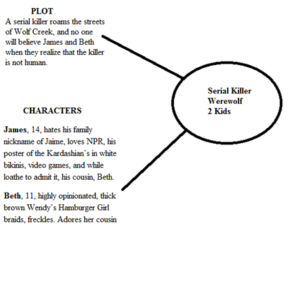
Setting & Timeline
Now we move on to SETTING and TIMELINE. The Setting for the story is Wolf Creek. The particular scene we are mapping, however, takes place in the baseball field. The pitcher’s mound to be exact. The Timeline for the entire story is the four month period from August 20 to December 19, 2013, but this particular scene occurs on September 15, fairly early in the story.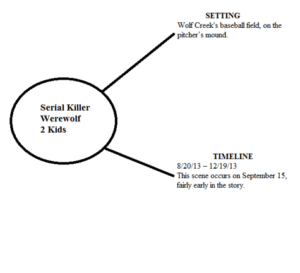
So when we put it all together, it looks something like this:
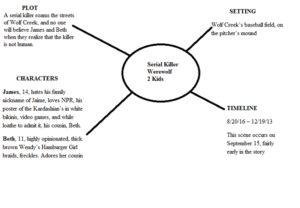
All the Pretty Colors, or The Final Product
So far, so good. But by now, you’re probably thinking that’s all well and good, but where are the pretty colors you promised us?
OOH! Shiny things! Look, skwerl!
*giggles*
Seriously. SKWERL!
To be honest, this is the part that I find difficult, but I know that many of you will just love it. And that’s great. More power to you.
Get out your markers, colored pencils, crayons. Even nail polish, if that’s what you have. And get ready to par-tay…
We’ve actually garnered a lot of material for our scene. Any category can lead to information being added to any other area. In this example, the characters’ ages lead us to the setting. Since they are kids, there aren’t a lot of options for privacy, so this all-important conversation, where Beth theorizes about the killer, has to take place somewhere out of earshot of the adults. Their choices are the kiddie park or the baseball field. It takes place on a Sunday, so while the park is likely to be filled with families, the baseball field should be empty. Thus, we can draw an arrow from Characters to Setting. Pull out your red marker.
We can draw another arrow from Plot to Timeline, since the scene takes place a mere three days before the next full moon, and, Beth is sure, the next murder. I used my blue crayon for this.
We can also draw lines from the items in the General Idea bubble outward, in this case to Plot. Just for kicks and giggles, I used my green pencil.
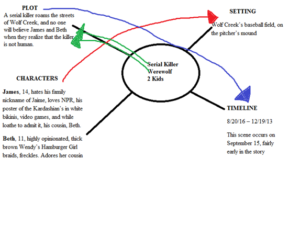
Of course, this is a very simple version. It can get much more complex, filled with as many characters, settings and events as your story warrants. Don’t forget to include any backstory that might have a bearing on your story in your timeline bubble.
Are we having fun yet?
I hope some of you will find this helpful. Remember, it’s just one example of how a mind map works. There are many, many possibilities. The only limit is your imagination. The world is your Pop-Tart. (I hate oysters…)
Next time, we’ll cover the two other methods my family uses to begin our stories — Index cards, and my favorite, the modified pantser method I call The Mind Meld.
***
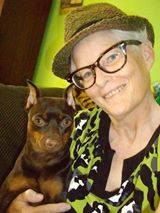 After sixteen years as a paralegal, I staged a coup and left the straight-laced corporate world behind forever. I now pander to my muse, a sarcastic little so-and-so who delights in getting the voices in my head to either all speak at once in a cacophony of noise or to remain completely silent. Only copious amounts of Diet Cherry Dr. Peppers and hamburgers will ensure their complicity in filling my head with stories of serial killers, werewolves, and the things that live under your bed.
After sixteen years as a paralegal, I staged a coup and left the straight-laced corporate world behind forever. I now pander to my muse, a sarcastic little so-and-so who delights in getting the voices in my head to either all speak at once in a cacophony of noise or to remain completely silent. Only copious amounts of Diet Cherry Dr. Peppers and hamburgers will ensure their complicity in filling my head with stories of serial killers, werewolves, and the things that live under your bed.
I live in SoCal, in the small town I fashioned Moonspell’s Wolf Creek after, with my beloved husband and persistently rowdy, always-has-to-have-the-last-word Miniature Pinscher, Fiona.
*O.C. Writers is a participant in the Amazon Services LLC Associates Program, an affiliate advertising program designed to provide a means for us to earn fees by linking to Amazon.com and affiliated sites. By clicking on the book links anywhere on this site, we earn a small commission from your purchase.

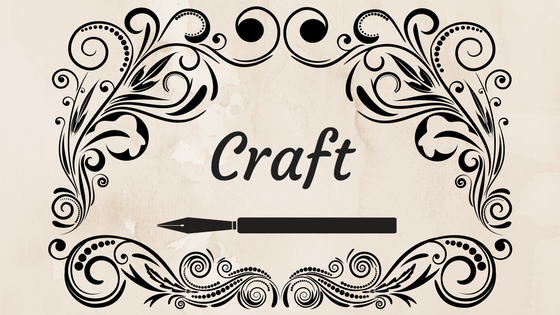

Well done, Lisanne! Maybe I should send you one of my “oversized” pieces of paper with all my colored circles and lines on it LOL For future reference , I use a drawing pad 12 X 18, or 18 X 24 if I can find one that size, and a whole package of colored Sharpie pens. I’m looking forward to the rest of your series.
LOVE this Lisanne! I’ve done Mind Maps of my stories, but I’ve never used all the cool colored pencils. Now I want to start plotting my next story.
Very informative and we’ll explained. You would be an excellent writing teacher.